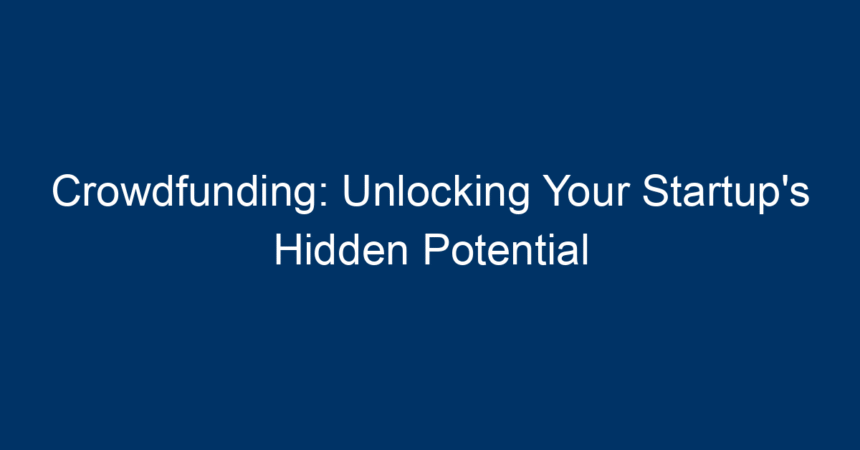Introduction
In today’s dynamic startup ecosystem, securing funding can often feel like an uphill battle. Traditional avenues like bank loans or venture capital seem out of reach for many budding entrepreneurs. However, a revolutionary solution has emerged: crowdfunding. This method not only democratizes the funding process but also harnesses the power of community to bring innovative ideas to fruition. In this article, we will explore the intricacies of crowdfunding, its benefits, platforms, and actionable insights for harnessing this potent resource to unlock your startup’s hidden potential.
What is Crowdfunding?
At its core, crowdfunding involves gathering small amounts of money from a large number of people, typically via the Internet. It provides a platform for entrepreneurs to present their ideas, products, or services and invite the public to invest in their vision. Crowdfunding can take many forms, including equity, rewards, donation-based, and debt crowdfunding.
Types of Crowdfunding
Understanding the different types of crowdfunding is crucial for shaping your fundraising strategy. Here are the most common types:
1. Reward-Based Crowdfunding
This is the most popular form of crowdfunding where backers contribute money in exchange for a reward—typically the product or service itself once it’s completed. Platforms like Kickstarter and Indiegogo are prime examples, allowing entrepreneurs to offer tiered rewards to entice backers.
2. Equity Crowdfunding
In this model, backers invest in a startup’s equity, thereby holding shares in the company. This method can provide significant funds, but it comes with complexities, such as compliance with securities regulations. Platforms like SeedInvest and Crowdcube facilitate this type of crowdfunding.
3. Donation-Based Crowdfunding
This type involves raising funds for non-profit projects or charitable causes. Donors might not expect any monetary return; their satisfaction comes from supporting a good cause. Platforms like GoFundMe are ideal for this kind of funding.
4. Debt Crowdfunding (Peer-to-Peer Lending)
This involves borrowing money from a large number of people with the promise of paying back the amount with interest. Platforms such as Funding Circle specialize in connecting borrowers to investors.
Why Choose Crowdfunding?
Crowdfunding presents several unique advantages for startups that can significantly impact their journey:
1. Access to Capital
With traditional funding methods often requiring extensive networks and resources, crowdfunding opens doors for entrepreneurs from diverse backgrounds. It democratizes fundraising, enabling startups to tap into a vast pool of potential investors.
2. Market Validation
Launching a crowdfunding campaign serves not only as a means to raise funds but also as a litmus test for your product or service. It provides early feedback from potential customers and helps refine your offering based on real-world insights.
3. Building a Community
Crowdfunding inherently fosters community building. Engaged backers become brand ambassadors, advocating for your startup and providing invaluable word-of-mouth marketing. This community can contribute ideas and feedback that help shape your product’s future.
4. Increased Visibility
A well-executed crowdfunding campaign can garner substantial media attention. When you showcase your startup on platforms like Kickstarter or Indiegogo, you tap into an established audience that seeks innovative projects to support.
Tips for Running a Successful Crowdfunding Campaign
Running a successful crowdfunding campaign requires strategic planning and execution. Here are actionable insights to guide you:
1. Craft a Compelling Story
At the heart of every successful crowdfunding campaign is an engaging narrative. Tell your story—why you started, the problem your product solves, and the impact it can create. Authenticity resonates with potential backers.
2. Set Realistic Funding Goals
Your funding goal should be grounded in reality. Consider factors like production costs, marketing, and shipping when determining an appropriate target. A well-researched goal helps inspire confidence among potential backers.
3. Create Engaging Visual Content
High-quality visuals are crucial for grabbing attention. Invest time in creating a professional video that succinctly outlines your mission and showcases your product. Visual storytelling significantly enhances engagement.
4. Engage with Your Audience
Interaction is key to maintaining momentum throughout your campaign. Regular updates, responding to comments, and sharing behind-the-scenes content keeps your backers engaged and eager to support your journey.
5. Utilize Social Media
Leverage social media platforms to amplify your reach. Utilize targeted advertising, post regular updates, and interact with your audience. Engaging content helps build excitement and directs traffic to your crowdfunding campaign.
6. Offer Attractive Rewards
Design tiered reward systems that incentivize different levels of giving. Exclusive rewards for early backers not only entice contributions but also create a sense of urgency.
7. Prepare for Success
Once your campaign is funded, be prepared for the next steps. Transparency about timelines, production issues, and shipping can help maintain trust with your backers.
Crowdfunding Platforms Overview
Navigating the numerous crowdfunding platforms can be overwhelming. Here are some of the most reputable platforms:
1. Kickstarter
Best for creative projects, Kickstarter has strict guidelines but boasts a massive audience. It operates on an “all-or-nothing” model, meaning campaigns only receive funds if they meet their goal.
2. Indiegogo
This platform offers flexibility with both fixed and flexible funding options. Indiegogo supports a broader range of projects, from tech and innovation to personal causes.
3. SeedInvest
For entrepreneurs looking to offer equity, SeedInvest connects startups with accredited investors and provides rigorous vetting.
4. GoFundMe
Ideal for personal projects and charitable causes, GoFundMe allows for donations without offering rewards or returns.
Case Studies of Successful Crowdfunding Campaigns
Examining successful campaigns can provide valuable insights. Consider the following examples:
-
Pebble Smartwatch raised over $10 million on Kickstarter, showcasing the power of engaging storytelling and building a community. Their clear benefits and real-life applications resonated with backers, leading to immense support.
- Exploding Kittens, a card game, became one of the most funded projects in Kickstarter history, demonstrating that humor and creativity can capture the imagination of potential backers. Their unique campaign offered compelling rewards and a funny narrative that attracted widespread attention.
Conclusion
Crowdfunding presents an unparalleled opportunity for startups to unlock their hidden potential. By tapping into the collective power of the community, entrepreneurs can not only secure funding but also build a loyal base of supporters. As you embark on your crowdfunding journey, remember to craft a compelling story, engage with your audience, and utilize the right platforms effectively. With dedication, creativity, and strategic planning, your startup can thrive in the ever-evolving landscape of entrepreneurship. Don’t just dream about your ideas; make them a reality through the transformative power of crowdfunding.




